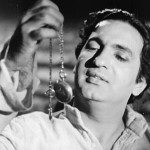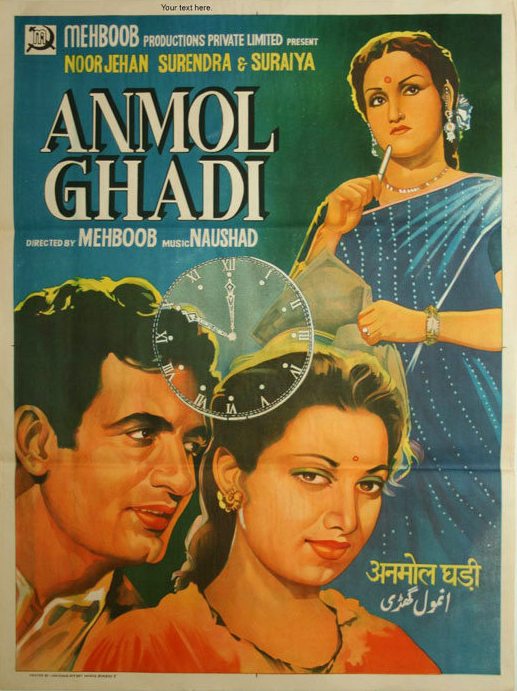Directed by Mehboob Khan
Written by Anwar Batalvi (story), Agha Jani Kashmiri (writer)
Starring Surendra, Noor Jehan, Suraiya
Music by Naushad, Tanvir Naqvi (Lyrics)
Cinematography Faredoon A. Irani
Release dates November 11, 1946
Running time 122 min
What makes most iteration on the Devdas story insufferable to me is not just the unkind, unpleasant, self-absorbed jerk that passes for its hero. What really seals the deal is  that this awful man is loved by not just one, but two women who really should be sensible enough to know better. Anmol Ghadi (“priceless watch”) sees these two women and raises the stakes. Its smug, indolent weenie of a hero can count not only on their love but also on the unwavering and entirely undeserved devotion of a tirelessly toiling mother and a sugar-daddy friend.
that this awful man is loved by not just one, but two women who really should be sensible enough to know better. Anmol Ghadi (“priceless watch”) sees these two women and raises the stakes. Its smug, indolent weenie of a hero can count not only on their love but also on the unwavering and entirely undeserved devotion of a tirelessly toiling mother and a sugar-daddy friend.
While his long-suffering mother (Leela Mishra) works her hands to the bone grinding flour to support him, Chander (Surendra) does not do much but laze about. Chander spends most of his time reading the poetry of an author known as Renuka Devi, the nom de plume of Lata (Noor Jehan), Chander’s long-lost childhood love. A plot device named Prakash (Zahur Raja) – apparently another childhood friend of Chander’s, dropped into the film with no explanation and no backstory – takes Chander and his mother to Bombay, and sets Chander up with his very own music shop. (His mother says that Chander was always more interested in sitars than anything else, but while we do see Chander make smug and demeaning comments about other people’s playing, he is not shown playing the instrument at any point during the movie.) Once in Bombay, he begins a search for Lata, who has also been pining for him all these years. But Lata’s willful, acidic friend Basanti (Suraiya) falls for Chander too. Melodramatic love triangle ensues.

I have wanted to watch Anmol Ghadi for some time to see the legendary Noor Jehan, who left Bombay at Partition and spent the rest of her life and career in Pakistan. And as dreary and grating as the film can be, it’s not because Noor Jehan isn’t lovely. Her moon-shaped face is of that quintessential midcentury type that you don’t seem to see any more, with creamy skin just made for soft-focus close-ups. And her long eyelashes are the perfect perch for wayward melodramatic tears. She is the Platonic form of 1940s movie star. And although Lata’s persistent love for the droning, obnoxious Chander is frustrating, it is nevertheless satisfying to see a female character who is a successful, famous author. Heroines with intellectual professions seem to have been more common in the middle of the 20th century than later.

Even so, Noor Jehan is not the best thing about Anmol Ghadi – that honor goes to Suraiya, salty and fresh and fun as Basanti whether she’s needling Lata or flirting with the unappreciative Chander. I really like this character, which makes her attachment to Chander that much more grating. She has so much wry energy, so much action in her, that you just want to shake her to her senses. And as much as I like the character, I also like the actor. I read that Suraiya was a very big star; one article compared her popularity to Nargis, though she does not seem to be remembered as well or with such reverence. She starred opposite Dev Anand in many of his early movies, and got top billing ahead of that rising superstar. So it goes for me with Hindi films; Anmol Ghadi has opened for me yet another interesting path to wander down; I can explore the films of this interesting actor.
And then there is the self-absorbed Chander, the leaden anchor dragging down this classic film. Had he been at all sympathetic or appealing, Anmol Ghadi would have been a lovely and engaging melodrama. Instead, it is a tiresome tale of the inexplicable sacrifice of four people whose love for the self-indulgent Chander is largely thankless. It doesn’t help, either, that Surendra is a singularly unappealing actor. Doughy, droopy-lidded and mumbling through smug half-smiles, he gives me the impression that Rajesh Khanna studied his work carefully in crafting his own rubber-lipped persona.
Anmol Ghadi does have some lovely songs; there is a reason that Noor Jehan, one of the last Hindi film actors to sing her own playback, is remembered as one of Hindi film’s greatest singers. It also features one of Rafi’s earliest songs, the somewhat sarcastic “Tera Khilona Toota”. So despite its warts – despite nearly everything about its hero, really – Anmol Ghadi is worth a watch if you, like me, are interested in the history of Hindi cinema and especially the movies that were tremendous hits in their time.
Written By:- Carla Miriam Levy
Originally Posted On:- www.filmigeek.com





